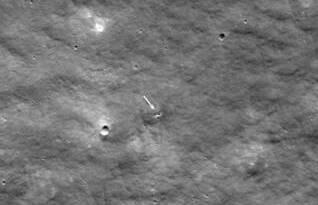Russia's failed space mission likely left a 33-foot crater on the moon

Russia's Luna-25 probe likely left a 33-foot-wide crater on the surface of the moon last month when it lost control and crashed down, NASA said Thursday, revealing images that show the suspected impact site.
Russia's first moon mission in 47 years ended in failure on August 19 when the Luna-25 probe smashed into the moon after a thruster firing went awry, cutting off communications and putting the spacecraft on the wrong orbital path, according to Roscosmos, the Russian space agency.
NASA's Lunar Reconnaissance Orbiter (LRO) spacecraft captured images last week of what the U.S. space agency described as a "new crater" after Roscosmos published an estimate of where the probe had struck.

"Since this new crater is close to the Luna-25 estimated impact point," NASA wrote in a statement, "the LRO team concludes it is likely to be from that mission, rather than a natural impactor."
Moscow has set up a commission to investigate exactly why Luna-25 crashed.
The failure was a major disappointment for the Russian space program, which was attempting to up its game amid renewed interest in the moon's southern polar region, where ice deposits may exist in permanently shadowed craters. Ice could offer future space missions a way to produce breathable air, water and even hydrogen rocket fuel.
The Russians have had little success with independent space exploration since the Luna-24 robot landed on the moon in 1976. It scooped up about six ounces of lunar soil and returned it to Earth in Russia's third successful robotic lunar sample return mission.
Twelve NASA astronauts walked on the moon a half century ago in the agency's Apollo program, but no Russian cosmonauts ever made the trip. Russia's only previous post-Soviet deep space robotic missions, both targeting Mars, ended in failure.
Luna-25 was an attempt to pick up the torch and put Russia back into a new space race of sorts, as the U.S., China, India, Japan and the private sector all plan multiple moon missions that could lay the foundations for lunar bases and eventual flights to Mars.
India's Chandrayaan-3 Vikram lunar lander made a historic touch-down near the moon's south pole just several days after the Russian probe crashed. It delivered a lunar rover that has already sent back data from soil samples.
William Harwood contributed to this report.
"Extremely dangerous" convicted killer escapes Pennsylvania prison
Denzel Washington | 60 Minutes Archive
Gayle King catches up with her high school teacher and reflects on her special senior year
